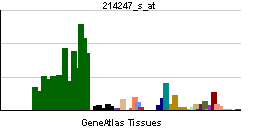DKK3
| Dickkopf homolog 3 (Xenopus laevis) | |||||||||
|---|---|---|---|---|---|---|---|---|---|
| Identifiers | |||||||||
| Symbols | DKK3 ; REIC | ||||||||
| External IDs | Template:OMIM5 Template:MGI HomoloGene: 8303 | ||||||||
| |||||||||
| RNA expression pattern | |||||||||
 | |||||||||
 | |||||||||
| More reference expression data | |||||||||
| Orthologs | |||||||||
| Template:GNF Ortholog box | |||||||||
| Species | Human | Mouse | |||||||
| Entrez | n/a | n/a | |||||||
| Ensembl | n/a | n/a | |||||||
| UniProt | n/a | n/a | |||||||
| RefSeq (mRNA) | n/a | n/a | |||||||
| RefSeq (protein) | n/a | n/a | |||||||
| Location (UCSC) | n/a | n/a | |||||||
| PubMed search | n/a | n/a | |||||||
Dickkopf homolog 3 (Xenopus laevis), also known as DKK3, is a human gene.[1]
This gene encodes a protein that is a member of the dickkopf family. The secreted protein contains two cysteine rich regions and is involved in embryonic development through its interactions with the Wnt signaling pathway. The expression of this gene is decreased in a variety of cancer cell lines and it may function as a tumor suppressor gene. Alternative splicing results in multiple transcript variants encoding the same protein.[1]
References
Further reading
- Maruyama K, Sugano S (1994). "Oligo-capping: a simple method to replace the cap structure of eukaryotic mRNAs with oligoribonucleotides". Gene. 138 (1–2): 171–4. PMID 8125298.
- Andersson B, Wentland MA, Ricafrente JY; et al. (1996). "A "double adaptor" method for improved shotgun library construction". Anal. Biochem. 236 (1): 107–13. doi:10.1006/abio.1996.0138. PMID 8619474.
- Yu W, Andersson B, Worley KC; et al. (1997). "Large-scale concatenation cDNA sequencing". Genome Res. 7 (4): 353–8. PMID 9110174.
- Suzuki Y, Yoshitomo-Nakagawa K, Maruyama K; et al. (1997). "Construction and characterization of a full length-enriched and a 5'-end-enriched cDNA library". Gene. 200 (1–2): 149–56. PMID 9373149.
- Krupnik VE, Sharp JD, Jiang C; et al. (1999). "Functional and structural diversity of the human Dickkopf gene family". Gene. 238 (2): 301–13. PMID 10570958.
- Tsuji T, Miyazaki M, Sakaguchi M; et al. (2000). "A REIC gene shows down-regulation in human immortalized cells and human tumor-derived cell lines". Biochem. Biophys. Res. Commun. 268 (1): 20–4. doi:10.1006/bbrc.1999.2067. PMID 10652205.
- Kobayashi K, Ouchida M, Tsuji T; et al. (2002). "Reduced expression of the REIC/Dkk-3 gene by promoter-hypermethylation in human tumor cells". Gene. 282 (1–2): 151–8. PMID 11814687.
- Strausberg RL, Feingold EA, Grouse LH; et al. (2003). "Generation and initial analysis of more than 15,000 full-length human and mouse cDNA sequences". Proc. Natl. Acad. Sci. U.S.A. 99 (26): 16899–903. doi:10.1073/pnas.242603899. PMID 12477932.
- Mao B, Niehrs C (2003). "Kremen2 modulates Dickkopf2 activity during Wnt/LRP6 signaling". Gene. 302 (1–2): 179–83. PMID 12527209.
- Clark HF, Gurney AL, Abaya E; et al. (2003). "The secreted protein discovery initiative (SPDI), a large-scale effort to identify novel human secreted and transmembrane proteins: a bioinformatics assessment". Genome Res. 13 (10): 2265–70. doi:10.1101/gr.1293003. PMID 12975309.
- Ota T, Suzuki Y, Nishikawa T; et al. (2004). "Complete sequencing and characterization of 21,243 full-length human cDNAs". Nat. Genet. 36 (1): 40–5. doi:10.1038/ng1285. PMID 14702039.
- Kurose K, Sakaguchi M, Nasu Y; et al. (2004). "Decreased expression of REIC/Dkk-3 in human renal clear cell carcinoma". J. Urol. 171 (3): 1314–8. doi:10.1097/01.ju.0000101047.64379.d4. PMID 14767340.
- Hoang BH, Kubo T, Healey JH; et al. (2004). "Dickkopf 3 inhibits invasion and motility of Saos-2 osteosarcoma cells by modulating the Wnt-beta-catenin pathway". Cancer Res. 64 (8): 2734–9. PMID 15087387.
- Roman-Gomez J, Jimenez-Velasco A, Agirre X; et al. (2004). "Transcriptional silencing of the Dickkopfs-3 (Dkk-3) gene by CpG hypermethylation in acute lymphoblastic leukaemia". Br. J. Cancer. 91 (4): 707–13. doi:10.1038/sj.bjc.6602008. PMID 15226763.
- Zhang Z, Henzel WJ (2005). "Signal peptide prediction based on analysis of experimentally verified cleavage sites". Protein Sci. 13 (10): 2819–24. doi:10.1110/ps.04682504. PMID 15340161.
- Gerhard DS, Wagner L, Feingold EA; et al. (2004). "The status, quality, and expansion of the NIH full-length cDNA project: the Mammalian Gene Collection (MGC)". Genome Res. 14 (10B): 2121–7. doi:10.1101/gr.2596504. PMID 15489334.
- Hsieh SY, Hsieh PS, Chiu CT, Chen WY (2005). "Dickkopf-3/REIC functions as a suppressor gene of tumor growth". Oncogene. 23 (57): 9183–9. doi:10.1038/sj.onc.1208138. PMID 15516983.
- Ftouh S, Akbar MT, Hirsch SR, de Belleroche JS (2005). "Down-regulation of Dickkopf 3, a regulator of the Wnt signalling pathway, in elderly schizophrenic subjects". J. Neurochem. 94 (2): 520–30. doi:10.1111/j.1471-4159.2005.03239.x. PMID 15998302.
- Kuphal S, Lodermeyer S, Bataille F; et al. (2006). "Expression of Dickkopf genes is strongly reduced in malignant melanoma". Oncogene. 25 (36): 5027–36. doi:10.1038/sj.onc.1209508. PMID 16568085.
- Urakami S, Shiina H, Enokida H; et al. (2006). "Combination analysis of hypermethylated Wnt-antagonist family genes as a novel epigenetic biomarker panel for bladder cancer detection". Clin. Cancer Res. 12 (7 Pt 1): 2109–16. doi:10.1158/1078-0432.CCR-05-2468. PMID 16609023.
| This protein-related article is a stub. You can help Wikipedia by expanding it. |